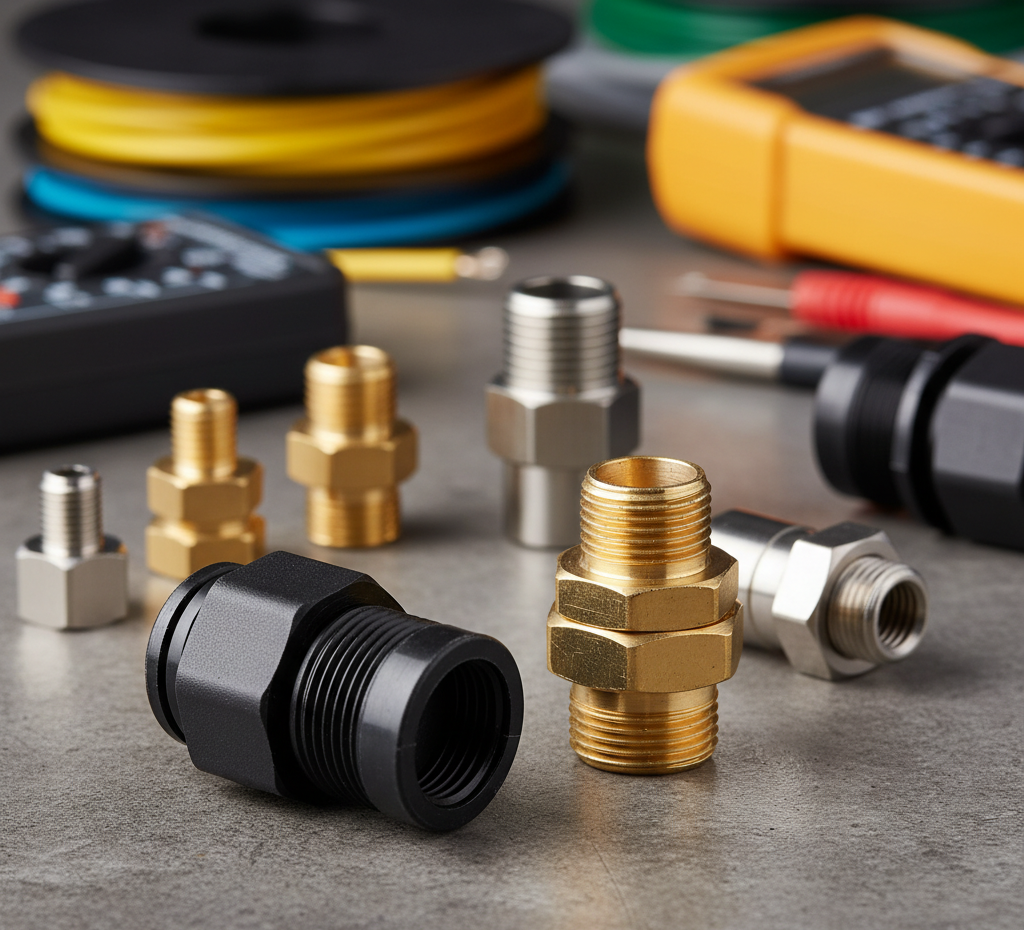Kingsgrove Branch:
Cable Gland

Right across Australia, from a residential switchboard in Sydney to a heavy-duty industrial site in the Pilbara, you'll find countless electrical cables entering enclosures, panels, and machinery. But have you ever stopped to look at the small fitting that allows this to happen safely? That, our friends, is the cable gland – a small but mighty component that plays a massive role in the safety and integrity of any electrical installation.
What Exactly is a Cable Gland?
A cable gland, sometimes known as a cable connector or fitting, is a device designed to attach and secure the end of an electrical cable to a piece of equipment, an enclosure, or a junction box.
Think of it as a specialised, high-performance doorway for your cable. It doesn't just let the cable pass through; it creates a secure and sealed connection. Its primary job is to perform several crucial functions all at once, ensuring the entire system remains safe and durable.
The Three Main Jobs of a Cable Gland
While it may look simple, a quality cable gland is expertly engineered to do three critical things:
1. Secure and Provide Strain Relief This is arguably its most important function. The gland firmly grips the cable, preventing it from being pulled out of the equipment. This "strain relief" is vital because it protects the delicate electrical connections inside from any stress or tension. Without it, a simple tug on the cable could disconnect wires, causing a power failure or a dangerous electrical fault.
2. Create an Environmental Seal Cable glands are essential for maintaining the Ingress Protection (IP) rating of an enclosure. They feature internal seals that compress around the cable jacket, creating a tight barrier against environmental elements. This is crucial for:
- Preventing Dust and Debris: Keeping conductive dust and other particles away from live terminals.
- Stopping Water Ingress: A waterproof cable gland (often rated to IP68) ensures that rain, moisture, and high-pressure jets don't get inside the enclosure, preventing short circuits and corrosion.
3. Earth Continuity For certain types of cables, like steel wire armoured (SWA) cables, specialised metallic cable glands are used. These glands not only secure the cable but also bond the metal armouring to the enclosure, ensuring a continuous earth connection, which is a critical safety feature.
Common Types of Cable Glands
Cable glands come in a variety of materials to suit different applications and environments:
- Nylon (Plastic) Glands: Lightweight, cost-effective, and corrosion-resistant. They are perfect for general-purpose applications, both indoors and outdoors.
- Brass Glands: Highly durable and robust, making them the go-to choice for industrial applications, outdoor installations, and use with armoured cables. They can be nickel-plated for extra protection.
- Stainless Steel Glands: Offer the ultimate in durability and resistance to corrosion, chemicals, and saltwater. You'll find these in harsh environments like marine settings, food processing plants, and chemical facilities.
Why Choosing the Right Gland is Not Negotiable
Selecting the correct cable gland is not just a matter of "making it fit." It's a critical decision for safety and compliance. Using the wrong size or type of gland can compromise the entire installation, leading to the failure of the seal, inadequate strain relief, and potential safety hazards. In Australia, proper cable entry and securing are requirements under the AS/NZS 3000 Wiring Rules to ensure mechanical protection and system integrity.
Sourcing Quality Cable Glands in Australia
For any professional electrician or project manager, using reliable and compliant components is key. When you need a comprehensive range of cable glands that you can trust for performance and durability, a specialist supplier is your best bet.
For example, Schnap Electric offers a wide selection of electrical products suitable for Australian conditions. Their range typically includes various cable glands, from versatile nylon glands for standard electrical work to robust brass and stainless steel options for more demanding industrial projects. Sourcing from a reputable supplier like Schnap ensures you get components that are built to last and meet the necessary safety standards.
Ultimately, the humble cable gland is a testament to the importance of small details in electrical work. It’s a vital component that keeps your connections secure, your systems protected from the elements, and the entire installation safe and compliant. So next time you see one, you’ll know the critical job it’s doing.
Recent posts

Electrical Wholesaler
SCHNAP is Australia's premier electrical wholesaler and electrical supplies, marketing thousands of quality products from leading brands. Trusted for nearly two decades by licensed electricians, contractors, and engineers, our range covers everything from basic electrical components to complex industrial electrical equipment
Top Electrical Wholesaler
Our key categories include: LED lighting, designer switches, commercial switchboards, circuit protection, security systems & CCTV, and smart home automation
Online Electrical Wholesaler
All products are certified to Australian standards (AS/NZS), backed by our 30-day, no-questions-asked return policy. Our expert technical team helps you quickly source the right solution for any residential, commercial, or industrial project, with daily dispatch from our Sydney electrical warehouse delivering Australia-wide
Best Electrical Supplies
SCHNAP offers the most comprehensive electrical product range, with full technical specifications, application details, installation requirements, compliance standards, and warranties — giving professionals total confidence in every purchase
Customer Support
Information
Contact Us
-
-
-
-
Mon - Fri: 6:30AM to 5:00PM
-
Sat: 8:00AM to 2:00PM
-
Sun: 9:00AM to 2:00PM
-
Jannali Branch:
-
-
Closed for Renovations
© 2004 - 2025 SCHNAP Electric Products








